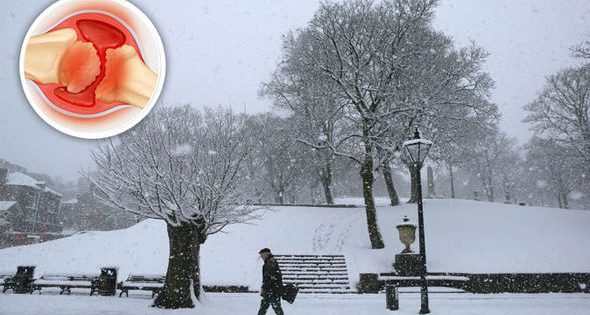Arthritis is inflammation of the joints. The symptoms of arthritis include stiffness and joint pain.
Read on to explore the relationship between arthritis symptoms and weather.
Many arthritis sufferers say that one specific weather condition worsens their pain significantly, to the extent that they can even predict when it’s coming.You may even be one of these people. There’s plenty of anecdotal evidence about the relationship between arthritis symptoms and weather.
“I used to hear people complain all the time that they knew rain was coming from the aching in their knees,” says Pam Snow, 54, of Denver, who has arthritis. “Now I’m one of those people!”
Snow has osteoarthritis in both knees. She typically manages her pain with exercise, diet, weight loss, and the occasional over-the-counter pain reliever, but when winter weather sets in, Snow faces an extra joint-pain challenge. “I think it’s related to barometric pressure,” she says. “It definitely has made me more cognizant of the weather.”
For Snow, arthritis isn’t just a personal problem. As vice president for community involvement for the Colorado Arthritis Foundation, she travels the state educating others about the condition. So she’s aware that there’s very little scientific evidence to support her own experience, and that of the legions of others with arthritis who feel worse when the weather is frightful.
There is some research to support the arthritis-weather connection, but some studies fail to provide conclusive evidence.
“In terms of really trying to scientifically study it, [research] is rather sparse and contradictory,” says rheumatologist Bonita S. Libman, MD, professor of medicine and division chief of rheumatology and clinical immunology at the University of Vermont College of Medicine in Burlington. Yet a lot of people do feel that weather affects their symptoms, Dr. Libman adds.
In fact, she says there may be some truth to the old wives’ tale that aching joints indicate a change in weather. According to some old studies Libman is familiar with, and which the Arthritis Foundation cites, people in barometric pressure chambers found that the lower the pressure, the more aches and pains they felt. A 2014 study of 222 patients with OA of the hip seemed to support that barometric pressure and relative humidity influence symptoms.
Another study showed that each 10-degree temperature drop was linked with an incremental increase in pain. And that rising barometric pressure also triggered pain in people with arthritis.
Blame it on the rain.
Many people with arthritis feel worsening symptoms before and during rainy days. A drop in pressure often precedes cold, rainy weather. This drop in pressure may cause already inflamed tissue to expand, leading to increased pain.
Elaine Husni, a rheumatologist at the Cleveland Clinic, says weather doesn’t cause arthritis or make it worse. But it can temporarily cause it to hurt more.
 People with OA or RA aren’t the only ones who link weather to increased arthritis pain. According to the National Psoriasis Foundation, warm weather may improve symptoms for some people with psoriatic arthritis. However, there is no conclusive evidence proving this link. Nonetheless, summertime may prove to be an easier time of year to be active outdoors.
People with OA or RA aren’t the only ones who link weather to increased arthritis pain. According to the National Psoriasis Foundation, warm weather may improve symptoms for some people with psoriatic arthritis. However, there is no conclusive evidence proving this link. Nonetheless, summertime may prove to be an easier time of year to be active outdoors.
The Academy of Orthopaedic Surgeons also links rainy weather and changes in weather to the potential for increased aches and pain of arthritis in the knees, hands, and shoulders.
The researchers express the hope that a study that links pain severity to weather conditions can help people to prepare and organize their activities around the times when their pain is likely to be at its worst.
Is it worth moving?
Alternatively, if there is no reason for you to be in Europe or North America during their rainiest months, large parts of the southern hemisphere are dry and sunny from September to May.
Should you move to a warmer climate to escape arthritis pain? According to the National Institute of Arthritis and Musculoskeletal and Skin Diseases, there is no evidence to support that changing location will make a long-term difference in RA.
Although drier, warmer weather may result in less pain, it doesn’t affect the course of the disease. Arthritis patients who reside in warmer climates are not spared from arthritis pain.
Many people move to a warmer, less harsh climate when they retire. This type of move may provide some benefits, but curing arthritis isn’t one of them.
Conclusion: Some previous studies have indicated that high barometric pressure and moisture may contribute to arthritis pain but, as Robert H. Shmerling, MD, the faculty editor at Harvard Health, admits after reviewing the available research, the studies are currently by no means consistent. Still, he does say that science clearly shows there is something to it.
Hopefully the researchers have not interfered with their findings by releasing preliminary results and creating an expectation in participants that rain would worsen their pain.
But first, we’d really appreciate it if you click the Facebook button and share this articles with your friends.
- Arthritis of the hand. (2013, December). Retrieved from http://orthoinfo.aaos.org/topic.cfm?topic=A00224
- Arthritis of the knee. (2014, June). Retrieved from http://orthoinfo.aaos.org/topic.cfm?topic=A00212
- Arthritis of the shoulder. (2013, January). Retrieved from http://orthoinfo.aaos.org/topic.cfm?topic=A00222
- Arthritis-related statistics. (2016, April 14). Retrieved from http://www.cdc.gov/arthritis/data_statistics/arthritis-related-stats.htm
- Bone, Muscle and Joint Team. (2012, June 14). The weather and arthritis: Does rain increase pain? Retrieved from https://health.clevelandclinic.org/2012/06/the-weather-and-arthritis-does-rain-increase-pain/
- Brennan, S. A., Harney, T., Queally, J. M., O’Connor McGoona, J., Gormley, I. C., & Shannon, F. J. (2012). Influence of weather variables on pain severity in end-stage osteoarthritis. International Orthopaedics, 36(3), 643-646. Retrieved from http://www.ncbi.nlm.nih.gov/pmc/articles/PMC3291761/
- Dorleijn, D. M., Luijsterburg, P. A., Burdorf, A., Rozendaal, R. M., Verhaar, J. A., Bos, P. K., & Bierma-Zeinstra, S. M. (2014, January 22). Associations between weather conditions and clinical symptoms in patients with hip osteoarthritis: A 2-year cohort study. Pain, 155(4), 808-813. Retrieved from http://www.ncbi.nlm.nih.gov/pubmed/24462921
- Handout on health: Rheumatoid arthritis. (2016, February). Retrieved from http://www.niams.nih.gov/Health_Info/Rheumatic_Disease/default.asp
- Mayo Clinic Staff. (2016, January 7). Arthritis. Retrieved from http://www.mayoclinic.org/diseases-conditions/arthritis/home/ovc-20168903
- Mayo Clinic Staff (2016, January 7). Arthritis: Symptoms and causes. Retrieved from http://www.mayoclinic.org/diseases-conditions/arthritis/symptoms-causes/dxc-20168905
- Shmerling, R. H. (2015, November 20). Can the weather really worsen arthritis pain? Retrieved from http://www.health.harvard.edu/blog/can-the-weather-really-worsen-arthritis-pain-201511208661
- Warmer weather, better joints? (2015, September 10). Retrieved from https://www.psoriasis.org/about-psoriasis/treatments/warmer-weather-better-joints
- Weather and arthritis pain. (n.d.). Retrieved from http://www.arthritistoday.org/about-arthritis/arthritis-pain/living-with-pain/weather-pain.php
You may also like:
